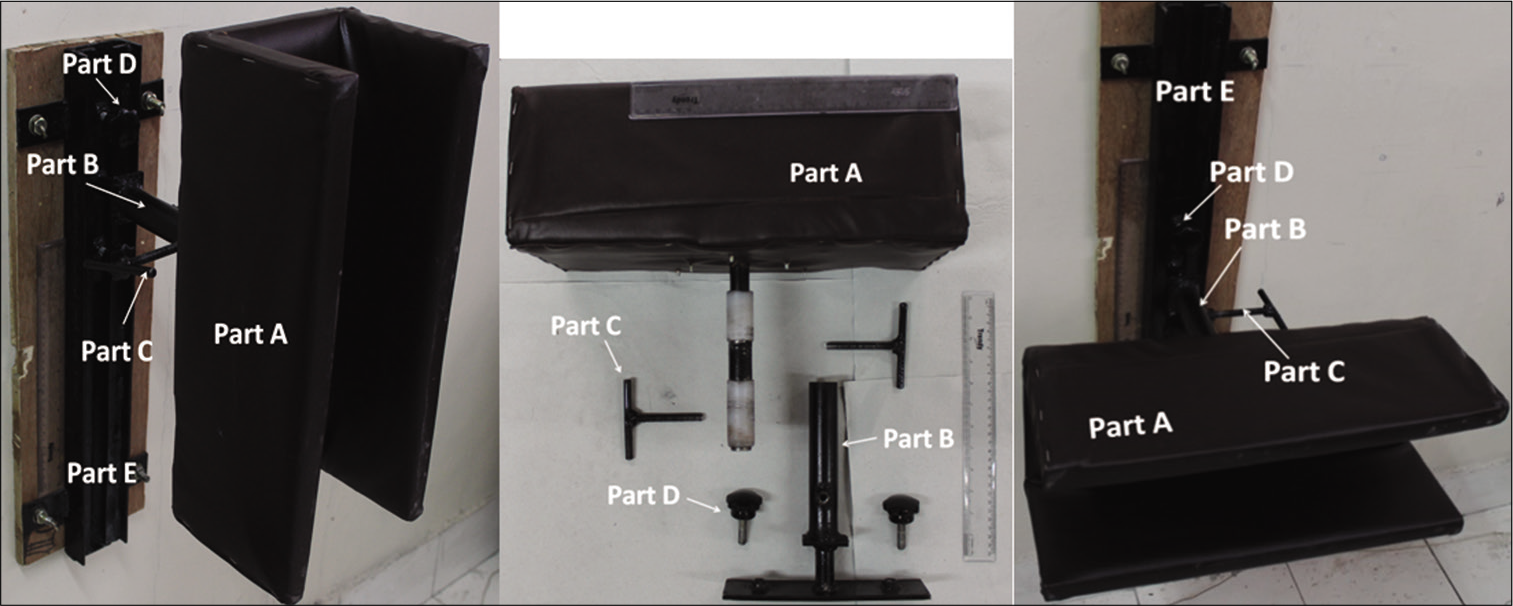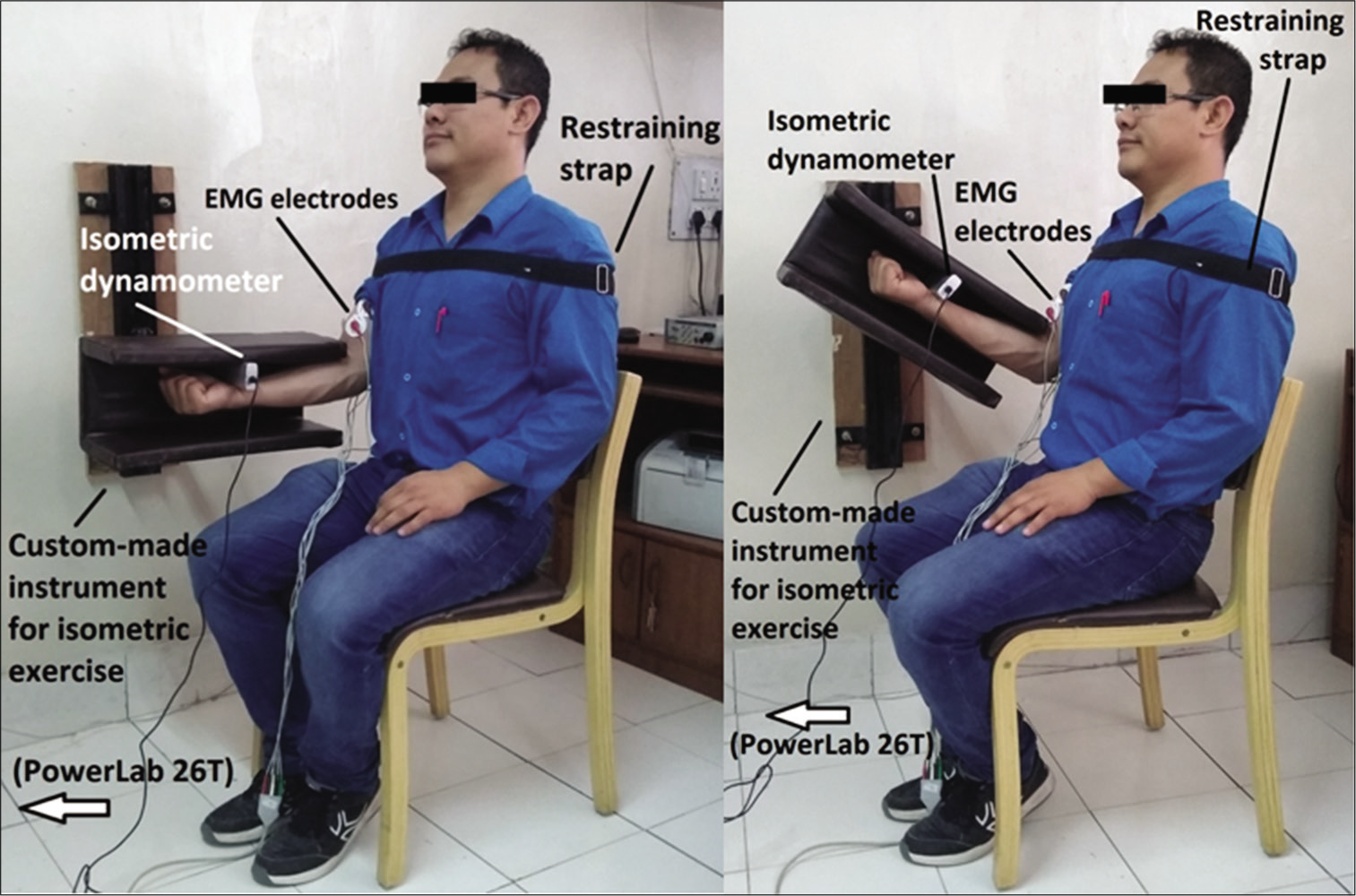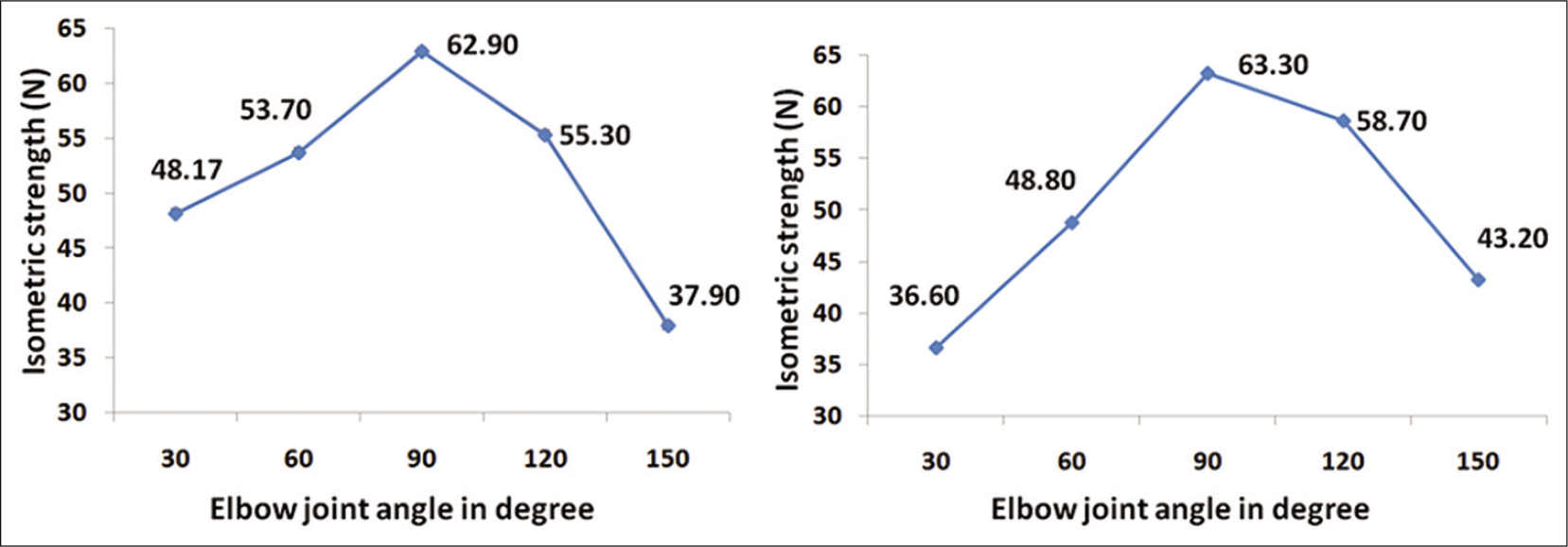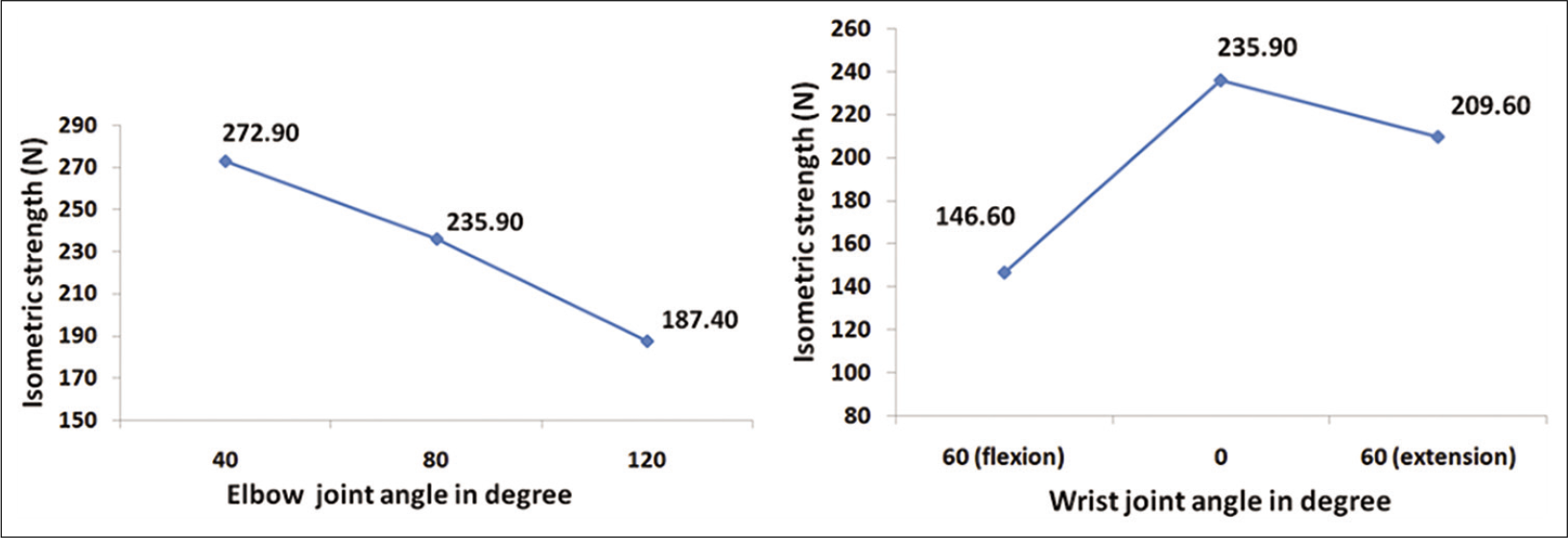Translate this page into:
Recording of length-tension relationship of elbow flexors and extensors by varying elbow angle in human
*Corresponding author: Prashant Tayade, Department of Physiology, All India Institute of Medical Sciences, Ansari Nagar East, New Delhi, Delhi - 110 029, India. r.prashanttayade@gmail.com
-
Received: ,
Accepted: ,
How to cite this article: Sharma HB, Das A, Tayade P, Deepak KK. Recording of length-tension relationship of elbow flexors and extensors by varying elbow angle in human. Indian J Physiol Pharmacol 2020;64(Suppl_1):S46-S50.
Abstract
Objectives:
The concept of length-tension relationship in skeletal muscle can be studied in a living person by demonstrating the relationship between isometric strength and joint angles. There is lack of an effective practical module to demonstrate this concept in living person, hence the study was planned.
Materials and Methods:
A simple, feasible and novel practical is designed using a custom-made isometric elbow flexion-extension exercising instrument, in which isometric elbow strength is measured using a dynamometer against various elbow joint angles measured using a goniometer.
Result:
Elbow isometric strength varied across its joint angles and was maximum at the optimum angle, which was 90°.
Conclusion:
We propose a simple and novel practical to understand the skeletal muscle length-tension relationship in a living person partly, by using the angle-strength relationship for undergraduate teaching in physiology.
Keywords
Length-tension relationship
Isometric strength curve
Elbow
Hand-grip
Novel undergraduate practical
INTRODUCTION
The force produced by a skeletal muscle is affected by its length at the time of the contraction, which is commonly referred to as length-tension or force-length relationship.[1,2] This is an important part of MBBS practical which is traditionally demonstrated using the in vitro sciatic nerve-gastrocnemius muscle preparation of frog, in which isometric force is measured at different muscle length.[3,4] However, the increasing unavailability of frog, and the ethical issues related to using and killing an animal, is a major setback.
Replication of this experiment in living person has two major challenges: firstly, the inability to measure intact muscle length and, secondly, the inability to measure the actual magnitude of the pull of a muscle on its bony attachment without using surgical intervention.[5] However, the change in the joint angle can be measured, and the muscular force acting on the bony segment, which actually is the torque (τ), can be estimated using an appropriate force transducer which provides measurements in equivalent force. The pattern of change of the strength, which is the maximal force measurement by the transducer, at different joint angles, can be determined and is called a strength curve.[1,5,6]
The change in the strength with joint angle is due to the change in muscle length and hence the muscular force production (length-tension relationship). This, however, is also due to the change in perpendicular distance from the line of action of the force to the axis of rotation (called moment arm).[1,6] Nevertheless, the concept of length-tension relationship can be understood partly from the isometric strength curve.
Hence, the present study was conducted with an aim to design an intelligible, informative, and feasible experimental paradigm for estimating isometric strength of elbow flexors and extensors at different elbow joint angles, so as to demonstrate the important concept of length-tension relationship to MBBS students.
MATERIALS AND METHODS
Materials required
A goniometer for measuring joint angle.
A pre-calibrated strain gauge-based isometric dynamometer with a linear response in the range of 0–800 N (MLT004/ST Grip Force Transducer), and PowerLab 26T (Model: ML4856) with LabChart 8 software (AD Instruments, New South Wales, Australia).
Restraining straps and a chair.
Elbow Isometric Exercise Instrument or EIEI [Figure 1]. This is a custom-made instrument for performing elbow flexors and extensors isometric exercise at different elbow joint angles, designed and developed by Dr. Hanjabam Barun Sharma under the guidance of Prof. Kishore K. Deepak.

- Elbow isometric exercise instrument, a custom-made instrument for performing elbow flexors and extensors isometric exercise at different elbow joint angles. Part E is fixed to a wall.
Experimental protocol
Principle
The concept of length-tension relationship in skeletal muscle can be demonstrated partly in a living person by measuring maximum isometric strength at various joint angles. Using an isometric dynamometer and a goniometer, elbow strength at various elbow joint angles is determined, and a graph is plotted between the two to understand the relationship.
Procedure
Measure the range of motion and the required joint angle of the elbow using a goniometer. Consider the following bony landmarks: centre of the acromion process, lateral epicondyle of the humerus, radial head, and radial styloid process. The angle of the elbow is measured from extension (toward 0°) to flexion direction, with the forearm in supination. Similarly, the range of motion and required angle of the wrist joint can be measured using the following landmarks: olecranon, ulnar styloid, triquetrum and lateral midline of the fifth metacarpal bone.[7]
After a general warm-up and a 5 min after two practice trails, ask the subject to perform maximum isometric contraction (MIC) for 5 s at 30°, 60°, 90°, 120° and 150° or angle at the maximum flexion. Different sets of elbow angles may also be used: 50°, 90° and 130°; or 40°, 80° and 120°; or 40°, 80°, 90° and 120° etc. The custom-made instrument is used for the same. The projected part A of the instrument can be rotated and fixed at any predefined angle to part B of the instrument using the two screws (part C). Part B is attached using two screws (part D) to part E, and part B can be glided up and down over the part E [Figures 1 and 2].
Ask the subject to do MIC with a 10 s break in between flexion and extension, which is done alternatively at each angle. The sequence of the angle of contraction is randomized, and a 3 min rest is given between each angle. Take three measurements with 5 min rest interval and their average is used for analysis.[8]
Motivate the subject maximally and encourage verbally to give his or her best effort. All the measurements are done with the subject sitting on a chair, and the arm aligned parallel to the midaxillary line of the thorax, with neutral (zero) rotation, adduction and abduction. Restraining straps are used to immobilize the chest and the lower legs.
Elbow MIC is recorded at each angle using an isometric dynamometer (MLT004/ST Grip Force Transducer) and PowerLab 26T (Model: ML4856) with LabChart 8 software (AD Instruments, New South Wales, Australia).
The dynamometer is placed such that its long axis and the plane of its surface with maximum area are perpendicular to the long axis of the subject’s forearm (radial styloid process and radial head are the reference points).
Draw the isometric strength curves for flexors and extensors of the elbow joint.
Similarly, hand-grip strength curve can be determined by measuring hand-grip strength using the isometric dynamometer at different elbow joint angles (e.g., 40°, 80°, 120° etc.) with neutral wrist joint angle (0°) and at different wrist joint angles: flexion (e.g., 60°), neutral (0°) and extension (e.g., 60°) while keeping the elbow at a fixed angle (e.g., 80°).

- Experimental set-up for data recording of isometric elbow flexors and extensors strength curve.
RESULTS
The representative isometric strength curves of flexors and extensors of the right-side elbow joint are shown in [Figure 3]. The isometric strength of both elbow flexion and extension is maximum at 90°, which are 62.90 N and 63.30 N, respectively. The angle at which maximum strength is observed in a strength curve is called an optimal angle.[1,5,6] In our case, it is 90° for the elbow joint.

- Isometric strength curves of elbow flexors (left) and elbow extensors (right) of the right side. Y-axis shows isometric strength in Newton, and X-axis shows elbow angle in degree. The optimal angle is 90° elbow angle (recording is done using isometric dynamometer with response range of 0–800 N at 1 k/s sampling rate).
Similarly, the optimal angle for right-side hand-grip strength curve at different elbow joint angles with the neutral wrist joint (0°) is 40°, and at different wrist joint angles with elbow joint at 80° are 0° (neutral) in our case [Figure 4]. The records presented here is for understanding purpose only, and also the subject of [Figures 3 and 4] is different.

- Isometric hand-grip strength curves of the right side with change in elbow joint angle (left) with the neutral wrist joint (0°), and change in wrist joint angle (right) with the elbow joint at 80°. Y-axis shows isometric strength in Newton, and X-axis shows elbow angle and wrist joint angle in degree, respectively. The optimal angle is 40° elbow angle and 0° wrist angle, respectively (recording is done using isometric dynamometer with a response range of 0–800 N at 1 k/s sampling rate).
DISCUSSION
The paper presents an innovative practical to demonstrate the important concept of not only length-tension relationship but also introduces the concept of angle-tension relationship and strength curve, which has significant application in the field of sports-exercise medicine and sciences, including physiology, kinesiology, biomechanics, rehabilitation and ergonomics. The set-up is relatively simple and cheap to arrange, if the isometric dynamometer and any digital data acquisition system are available. If the same are not available, in place of elbow flexors or extensors, the isometric strength curve of hand-grip exercise at different elbow and wrist joint angles can be demonstrated using any available hand-grip dynamometer and a goniometer.
The assessment of learning of this demonstration practical may be done as a part of an objectively structured practical examination with question stations based on the strength curve, and the physiological mechanisms behind.
Further extension of the practical may be done by including the component to study the effect of change in shoulder joint angle on elbow flexors and extensors strength curve at a fixed elbow joint angle. Additional measure like electromyography (EMG) may be included as the strength curve is affected by motor unit activation (recruitment and firing frequency) among others,[1] and to demonstrate the effect of joint angle on EMG characteristics as a part of postgraduate teaching and practical. Furthermore, the effect of fatigue, training, previous contraction history and type (concentric, isometric and eccentric), upper limb cross-sectional area, and various other anthropometric characteristics on the strength curve can be studied. By designing similar instrument(s) for isometric exercise at various joints, isometric strength curves of different muscle groups may be studied, for example, knee and hip flexors and extensors.
ACKNOWLEDGEMENT
The authors expressed their sincere acknowledgement to the Central Workshop, AIIMS, New Delhi for making the isometric elbow flexion and extension exercise instrument by converting our idea and design from a piece of paper into a reality; and also to Dr. Sankalp and Dr. Gagan Kumar Banodhe, for extending help in various stages, in the developmental of the instrument.
CONCLUSION
We propose a simple and novel practical to understand the skeletal muscle length-tension relationship in a living person partly, by using angle-strength relationship for undergraduate teaching in physiology. We recorded isometric strength curves of flexor and extensor muscles of right elbow, and also of right hand-grip, using a custom-made instrument.
Declaration of patient consent
The authors certify that they have obtained all appropriate patient consent.
Financial support and sponsorship
Nil.
Conflicts of interest
There are no conflicts of interest.
References
- Physiological bases for athletic training In: The Physiology of Training for High Performance. Oxford, UK: Oxford University Press; 2014. p. :1-147.
- [Google Scholar]
- Contraction of skeletal muscle In: Guyton and Hall Textbook of Medical Physiology (13th ed). Philadelphia, PA: Elsevier; 2016. p. :75-88.
- [Google Scholar]
- All India Institute of Medical Sciences. Available from: https://www.aiims.edu/aiims/academic/aiimssyllabus/Syllabus%20-%20MBBS.pdf [Last accessed on 2018 Sep 12]
- [Google Scholar]
- Joint Structure and Function: A Comprehensive Analysis (4th ed). Philadelphia, PA: F.A. Davis Company; 2005.
- [Google Scholar]
- ACSM’s Foundations of Strength Training and Conditioning Philadelphia, PA: Wolters Kluwer Health/ Lippincott Williams and Wilkins; 2012.
- [Google Scholar]
- Measurement of Joint Motion: A Guide to Goniometry (3rd ed). Philadelphia, PA: F.A. Davis Company; 2003.
- [Google Scholar]
- The effects of elbow joint angle changes on elbow flexor and extensor muscle strength and activation. J Phys Ther Sci. 2014;26:1079-82.
- [CrossRef] [PubMed] [Google Scholar]






